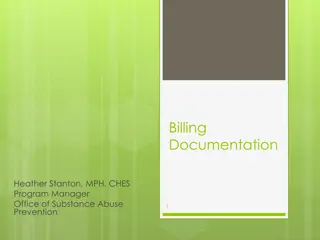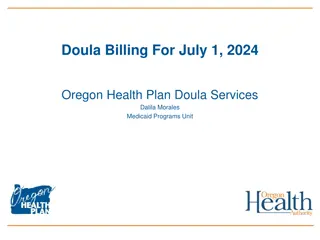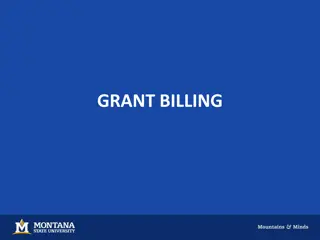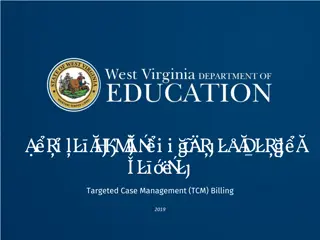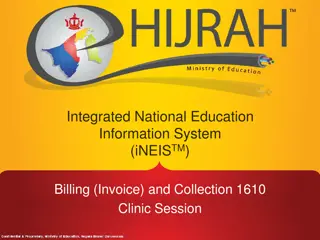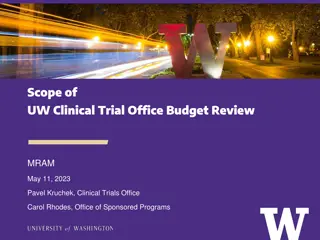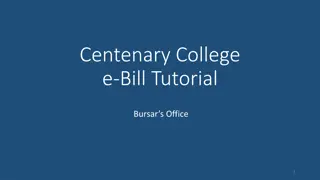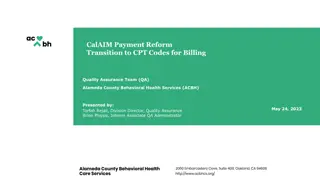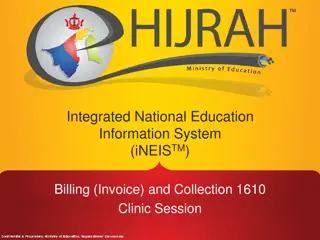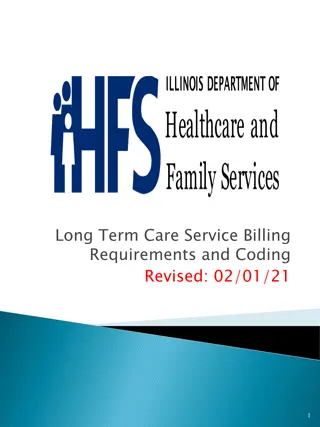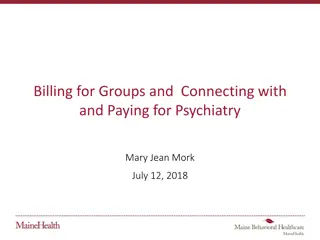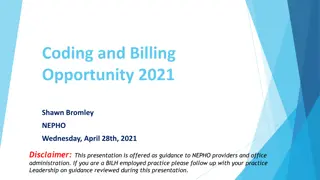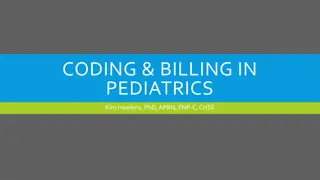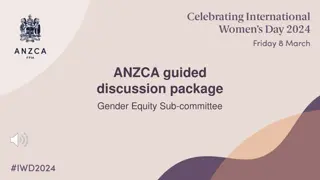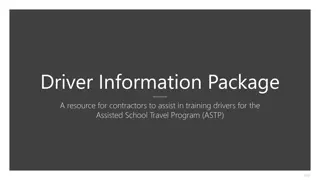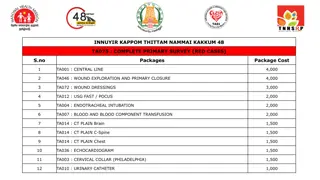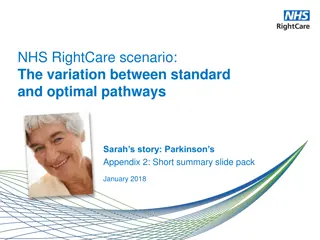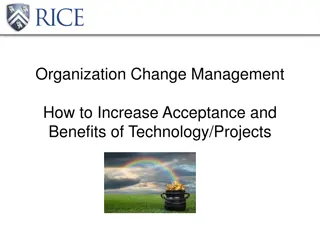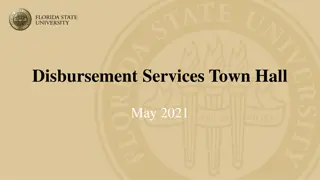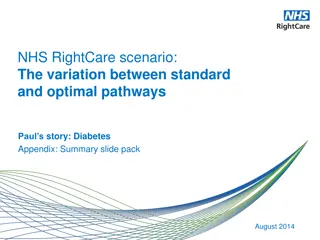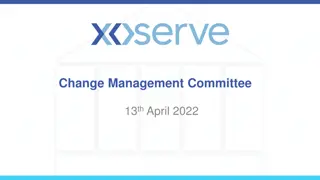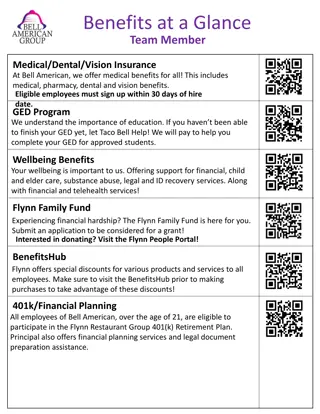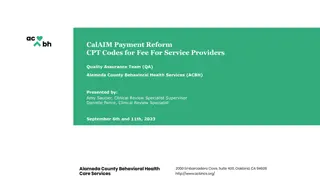Optimal Billing Practices for Financial Management Change Package
Explore the importance of billing the correct payer and optimal amount, challenges faced, strategies to improve billing practices, and available tools for support. Learn about revenue optimization, meeting objectives, and suggested performance indicators in financial management.
Download Presentation

Please find below an Image/Link to download the presentation.
The content on the website is provided AS IS for your information and personal use only. It may not be sold, licensed, or shared on other websites without obtaining consent from the author. Download presentation by click this link. If you encounter any issues during the download, it is possible that the publisher has removed the file from their server.
E N D
Presentation Transcript
Bill the Correct Payer and Optimal Bill the Correct Payer and Optimal Amount Amount Financial Management Change Package Best Practice 1
Financial Management Financial Management Change Package Change Package Best Practice Best Practice Recommendations Recommendations 1. Bill the correct payer and optimal amount 2. Monitor and manage client fee collections 3. Monitor and manage payments from third-party payers (TPPs) Link: https://www.fpntc.org/resources/financial-management-change- package 2
Financial Management Financial Management Change Package: Change Package: Best Practice 1 Best Practice 1 Bill the correct payer and Bill the correct payer and optimal amount. optimal amount. 3
Meeting Objectives Meeting Objectives By the end of today, you should be able to: By the end of today, you should be able to: Describe the importance of billing the correct payer and optimal amount Describe challenges related to billing the correct payer and optimal amount Describe at least one strategy to bill the correct payer and optimal amount Describe one tool available to support front-end practices 4
Rationale for Billing the Rationale for Billing the Correct Payer and Optimal Correct Payer and Optimal Amount Amount Revenue optimization begins with assuring: Revenue optimization begins with assuring: Correct payer is billed Charges are accurate Accurate discounting of services Accurate coding of services Full charge for services is appropriate 5
Suggested Performance Suggested Performance Indicators Indicators to Bill the Correct Payer and to Bill the Correct Payer and Optimal Amount Optimal Amount Can be broken out by: Uninsured/self-pay clients Medicaid Private insurance Monthly Charges Sub-indicators related to monthly charges Broken out by: Uninsured/self-pay clients, Medicaid, and private insurance Charge per client Client in each discount category Broken out by: Number and/or percentage Link: https://www.fpntc.org/resources/financial-management-performance- report-and-improvement-plan 6
Suggested Performance Suggested Performance Indicators Indicators to Bill to Bill the Correct Payer and the Correct Payer and Optimal Amount (cont.) Optimal Amount (cont.) Can be calculated by: Visits Revenue Payer Mix Sub-indicators related to Payer Mix Medicaid applications (submitted) Broken out by: Number of applications submitted Medicaid applications (approved) Broken out by: Percentage 7
Payer Mix Impact Payer Mix Impact Grantee Example, 2015 Data % of Health Insurance Coverage Number of Encounters (Visits) Payer as a % of Total Revenue Revenue per Encounter (Visit) Encounters (Visits) Revenue 98,721 40% $10,912,653 72% $111 Medicaid 77,071 31% $2,904,005 19% $38 Private Insurance Uninsured/ Self-Pay Unknown Total 69,992 28% $1,432,484 9% $20 2,992 1% 248,776 $15,249,142 8
Accurate Family Size and Accurate Family Size and Income Charges Impact Income Charges Impact Example of QI initiative focused on accurate gathering of family size & income for uninsured/self-pay clients No fee 25% fee 50% fee 75% fee 100% fee Total Revenue # % # % # % # % # % Pre QI Initiative Clients in each discount category 140 93% 4 3% 2 1% 2 1% 2 1% $550 Post QI Initiative Clients in each discount category 80 53% 40 27% 15 10% 10 7% 5 3% $3,000 Monthly Revenue Difference $2,450 Total clients in both scenarios is 150; full charge for each visit is $100 9
Discussion of Discussion of Challenges Challenges What are your What are your agency s challenges agency s challenges related to billing the related to billing the correct payer and correct payer and optimal amount? optimal amount? 10
Discussion of Discussion of Challenges (cont.) Challenges (cont.) Time Training Policies and procedures that are not clear Data extraction issues User knowledge System limitations Cost analysis-related issues 11
Overview of Strategies Overview of Strategies for Best Practice 1 for Best Practice 1 Develop and/or update policies and procedures Conduct cost analysis, utilize data to inform fee schedule adjustments, and to make other business decisions Implement front-end procedures that assure accurate gathering of TPP, family size, and income information Provide training on documentation and coding 12
Strategies for Policies Strategies for Policies and Procedures and Procedures Think about frequency or approach to reviewing and/or developing policies and procedures Suggested topics to include in policies and procedures on: Scheduling communications Check-in data gathering and communications Insurance verification/gathering of all insurance information Family size & income information gathering/income verification Minors 13
Charging the TPP and Charging the TPP and Confidential Services Confidential Services Inaccurate client communication Do you want confidential services? Accurate client communication. Explain: All All services are confidential Billing may not be Is the EOB suppressed and/or can an EOB be mailed safely? NFPRHA Resource, Managing Family Planning Revenue Cycles & Workbook 14
Importance/Value of a Importance/Value of a Cost Analysis Cost Analysis Knowing the cost of providing services is a Title X requirement Recommended to conduct annual cost analysis Is more than a requirement it s an opportunity to use your data to: Inform fee schedule adjustments Make informed business decisions 15
Using Cost Analysis Data Using Cost Analysis Data Adjusting Fee Schedule Adjusting Fee Schedule Compare costs to industry standards Compare costs to current fees for each service Compare costs and fees to TPP rates Compare costs to market rates 16
Fee Schedule Example Fee Schedule Example Importance of Charges TPP 1 Scenario 1: Agency s charge is $90 Scenario 2: Agency s charge is $120 Scenario 3: Agency s charge is $130 $4,500 per month $6,000 per month $6,000 per month Annual Revenue Difference $18,000 Scenario assumes insurance contracted reimbursement rate for the service is $120 Scenario assumes that this client service is provided 50 times per month for this TPP, all deductibles met for non-essential health services 17
Using Cost Analysis Data Using Cost Analysis Data Making Informed Business Decisions Making Informed Business Decisions Set informed fees, develop schedule of discounts Make informed decisions on TPP contract rates Assess need to modify expenses or services Determine if services provision costs are on par with market rates Assess profitability Measure productivity Make budgeting decisions Allocate expenses 18
Cost Analysis Tool Cost Analysis Tool 19 Cost Analysis Training Package
Strategies for Front Strategies for Front- -End Procedures Procedures End Scheduling process Communicate policies with client Front-end processes Gather accurate client information Demographic information Insurance coverage Electronic verification system (EVS) Family size and income Authorization process 20
Strategies for Providing Strategies for Providing Training Training Provide training to clinical team on documentation and coding Provide training to front desk staff on front- end policies and procedures Observe your team Monitor team performance Performance indicators Chart audits 21
Coding Tools Coding Tools FPNTC Coding Training Package 22 NFPRHA Revenue Cycle Management Resources
Case Scenario Case Scenario As you gather information for FPAR, you note 91% of your clients are in the full (100%) discount category. Your grantee shares that the average percentage for other sites in the network is 74%. While some differences among sites are to be expected in this metric, you are concerned that there may be an issue with information gathering at your front desk (based on this information). What do you do? What do you do? 23
Success Story Success Story The Florida Department of Health, a Title X grantee, wanted to focus on the process of enrolling clients in their Medicaid waiver program as staff determined 46% of prior applications across the state were either denied and/or had errors. Actions Actions Taken: Grantee staff focused on the application process with one site in their network They analyzed the application error data to identify reasons for errors Based on the error types, they developed a detailed process and flow chart for application completion, and shared with the site The grantee incorporated site feedback Training on the tools was conducted Taken: 24
Success Story (cont.) Success Story (cont.) Results: Results: At the end of the QI initiative, the Medicaid application approvals increased by 10%. Statewide error rates decreased by 38%. Key points/lessons learned: Key points/lessons learned: Small changes can make a big impact Observation and communication are key disseminating a policy alone likely won t have the impact you want You don t always have the answer involve staff involved in the process 25
What other What other questions do questions do you have? you have? What other What other issues would issues would you like to you like to discuss? discuss? 26
Thank you! Thank you! Contact: fpntc@jsi.com 27


